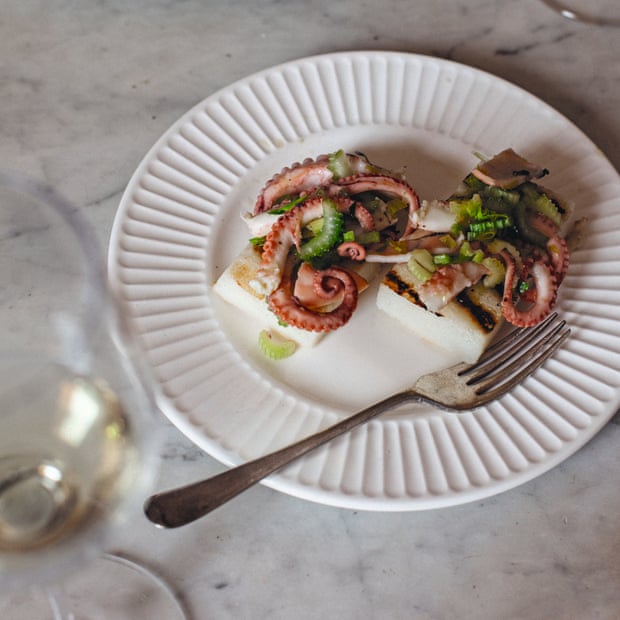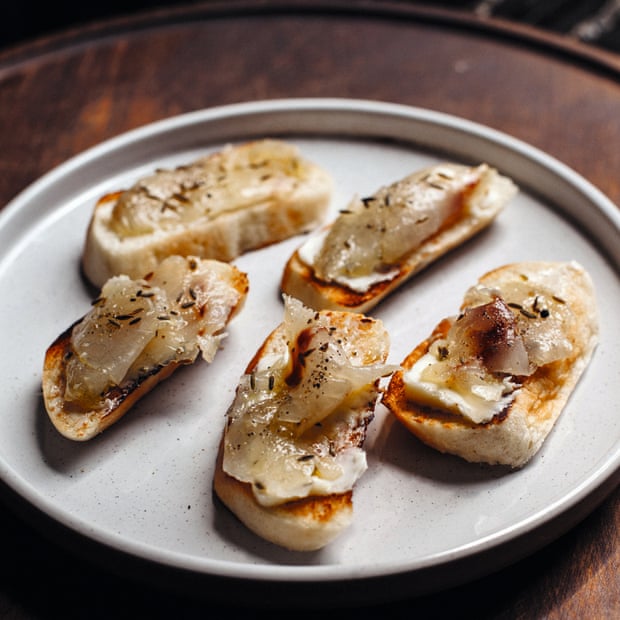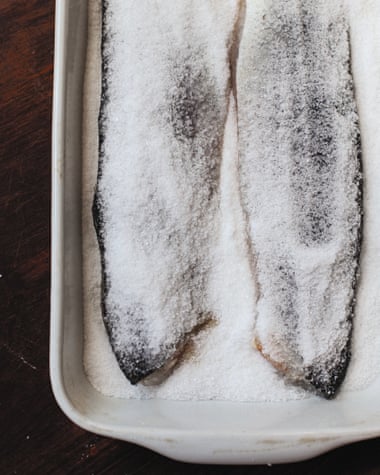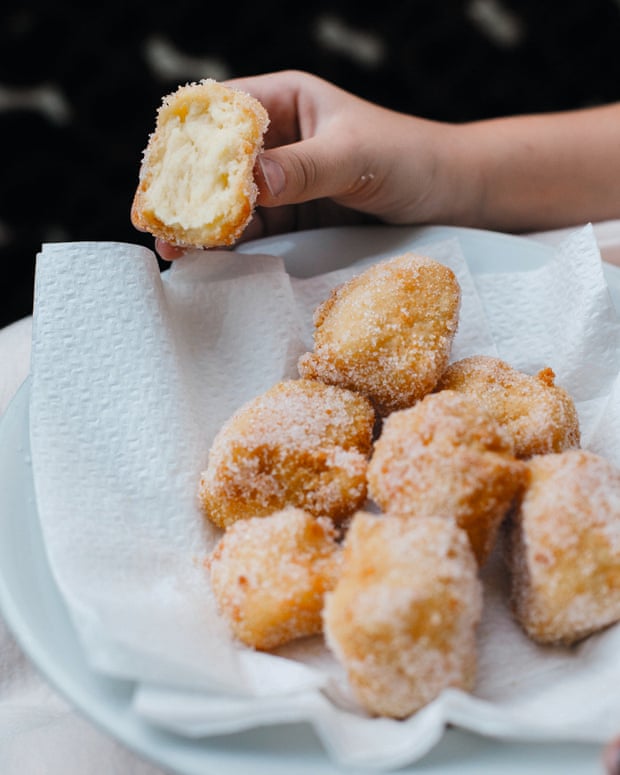
Cicchetti are a way of life in Venice. Think of these morsels as appetisers, aperitivo, hors d’oeuvres or (if you must) compare them to Spanish tapas.
They are generally small enough to be eaten in one or two bites; you can hold them with one hand while the other holds a spritz. Typical cicchetti include warm and cold dishes, plenty of seafood – which the lagoon city is known for – and meat, eggs, salumi and vegetables.
Moscardini col sedano (baby octopus with celery)
This is a bright and refreshing dish, with a delightful crunch. You could add boiled potatoes, halved fresh cherry tomatoes or marinated black olives. But I do enjoy the simplicity of this two-ingredient salad.
The octopus needs to be cleaned before using. If bought frozen, they usually have already been cleaned. If fresh, you can ask your fishmonger to do this or, to do it at home simply remove the beak, cut out the eyes, empty the head and rinse thoroughly.
Makes 6
3 medium-sized baby octopus (about 500g)
2 celery stalks, leaves and all, finely sliced
2 tbsp olive oil
Juice of ½ lemon
Grilled polenta, to serve
Bring a pot of water (deep enough to cover the octopus) to a rolling boil. Some like to make the tentacles extra curly; to do this, dip the octopus in the boiling water up to its tentacles, then pull it out and repeat two or three times until the tentacles are curled. Immerse the octopus in the boiling water, turn the heat down to a simmer and cook over a low-medium heat until they are very tender (a fork should easily pierce through), about 45 minutes.
Remove from the water and when cool enough to handle, pull the skin off (which can be a little gelatinous). Rinse, then roughly chop each octopus, separating the tentacles.
Place in a bowl. Add the celery and its leaves with the olive oil, lemon juice, and salt and pepper, adjusting the seasoning to your taste, then toss together. Serve with grilled polenta.
Branzino marinato al cumino (cured sea bass with cumin)

This dish is inspired by a recipe in the Slow Food-produced cookbook, Ricette di Osterie del Veneto, from Ristorante Al Vecchio Marina. The use of a spice like cumin, which is rare in Italian cuisine, is perfectly suited to this dish. It is also an intriguing choice to cure a fish such as sea bass – which in Venice is prized for its delicate flesh and is traditionally roasted or boiled for very special occasions, such as Christmas Eve.
You need to begin this recipe at least two days before you want to serve it (five days, according to the traditional recipe, but I cannot wait that long).
Makes 20
1 whole sea bass (about 1kg), or 2 sea bass fillets, scaled but skin on (about 800g)
120g coarse salt
120g raw sugar
Juice of 1 lemon
1 tsp honey
1 tsp cumin seeds, crushed, plus a pinch for garnish
2–3 tbsp extra-virgin olive oil
20 baguette slices
1 garlic clove
Butter, softened

To fillet the whole fish, first make a diagonal slice that almost cuts the head off and follows the opening of the gills. From here you will cut the first fillet by locating the backbone, and using the spine as a guide, cut all the way along the length of the fish to the tail and pull out the first fillet.
Now flip the fish over and repeat. You should be left with a head and bones and tail all attached. This makes the most wonderful stock for a fish soup or a fish risotto, so set it aside.
Otherwise, ask your fishmonger to fillet it for you (and if you would like to keep the rest for stock, do tell them).
Gently run the fillets under cold water then pat them dry. Combine the salt and sugar and sprinkle about half of this mixture in a glass or ceramic dish, place the fillets on top, skin side up, then cover completely with the rest of the sugar and salt mixture. Place in the fridge to cure for 24 hours.
The next day, remove the fish from the curing mixture, gently rinse and pat dry. Place in a new, clean glass or ceramic dish. Combine the lemon juice with the honey and cumin and pour this over the fish and leave to marinate for another 24 hours.
Remove the fish from the marinade and pat dry gently. Slice the fish on a slight diagonal; you want to do this as thinly as possible and then discard the skin. Dress the cured fish with a generous drizzle of very good olive oil and some crushed pink or black pepper, and another pinch of cumin. Cover and leave to rest until ready for serving. (It can be kept like this for at least three days in the fridge).
When ready to serve, toast the baguette rounds and rub each once with a fresh garlic clove before buttering them, all while the bread is still warm. Place a slice of cured sea bass on top and serve immediately.
Crema fritta (deep-fried custard)
Fried custard is a specialty of the Venetian carnevale, and from 17 January for the feast day of Anthony the Great until Mardi Gras, you can find these sugar-crusted golden cubes in Venice’s bakeries, pastry shops and bacari (bars). Sometimes, they are even made with sweet polenta cooked in milk until creamy instead of custard.
Makes 16
2 whole eggs
2 egg yolks
200g sugar
120g all-purpose flour
500ml full-cream milk
Zest of 1 lemon
1 tsp vanilla extract
100g dry breadcrumbs
Vegetable oil, for frying

Separate the eggs and set aside the whites for later. Whisk the four egg yolks in a heavy-bottomed saucepan with half of the sugar. Add the flour and whisk again to a smooth, thick paste. Add the milk, bit by bit at the beginning, until you have a smooth, fluid mixture. Add the lemon zest and vanilla, and place the saucepan over a low heat.
Using a wooden spoon or a whisk, keep an eye on the custard as it heats, stirring slowly but constantly to ensure it doesn’t catch at the bottom (the edges of the pan are the first place it will start to thicken). Once the mixture begins to thicken, you will need to stir more frequently to ensure it stays smooth, and keep stirring until it is quite thick and semi-solid – the custard should hold its shape. This should take about 20 minutes.
Scrape the custard out of the saucepan and into a buttered, rectangular shallow dish (something like a brownie pan is ideal) and let this mixture cool completely, covered. You can do this the day before and leave it overnight in the fridge if you prefer. Once cooled, cut the custard into 16 squares, around three by three centimetres, or whatever makes the most sense in your pan.
Whisk together the two egg whites set aside from earlier in a shallow bowl. In another shallow bowl, place the breadcrumbs. Dip the cubes of custard first into the egg white to cover all sides and then into the breadcrumbs the same way and place them on a clean plate until all the custard is crumbed.
Prepare another shallow bowl with the rest of the sugar.

Place enough oil in a small saucepan to cover the cubes of custard (about four centimetres minimum) and heat over a medium heat. It should be about 160C, or if you don’t have a candy thermometer, you can test the oil by dipping the end of a wooden spoon into it – it should bubble like prosecco immediately.
Fry the custard in small batches for about 90 seconds, or until they are golden brown. Drain on kitchen paper briefly then toss the hot fried custard into the sugar, rolling it on all sides to coat. You must do this while the custard is piping hot or the sugar won’t stick. You can serve immediately or even enjoy them at room temperature, but these are best eaten on the day they are made.



